French-German actor Ivan Desny (1922-2002) was a cosmopolitan film star with a truly European film career that spanned four decades. In the years after the war he appeared in British, French, Italian and German films before he became one of the protagonists of the Neue Deutsche Welle - the German New Wave of the 1970s.
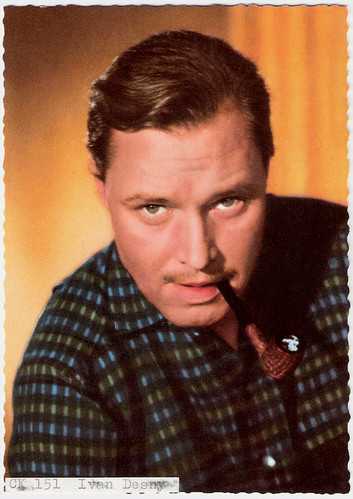
German postcard by UFA/Film-Foto (Universum-Film Aktiengesellschaft, Berlin-Tempelhof), no. CK-151. Photo: Arthur Grimm / UFA.
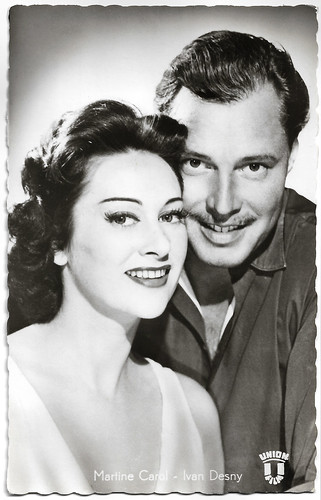
German postcard by Kolibri-Verlag G.m.b.H. Minden/Westf., no. 1719. Photo: Gamma / Union / Vogelmann. Publicity still for Lola Montez (Max Ophüls, 1955) with Martine Carol.
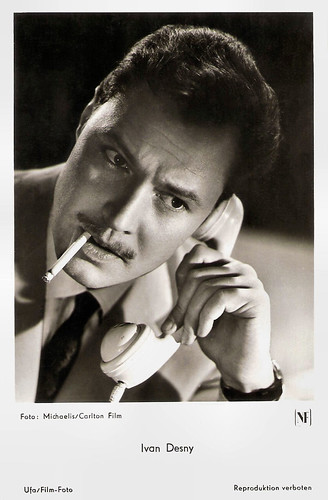
German postcard by Ufa, Berlin-Tempelhof, no. FK 3021. Photo: Michaelis / Carlton Film / NF. Publicity still for Rosen für Bettina/Ballerina (Georg Wilhelm Pabst, 1956).
Ivan Desny was born Ivan Nikolai Desnitzky in Peking (now Beijing), China, in 1922. He was the son of a Russian diplomat and a Swedish mother. As a child, he lived in Teheran, Washington, Paris and Brisbane.
It was his bad luck to be in Paris when the Nazis marched in. He spent the war in a German labour camp along with thousands of other Russian expatriates. After the war, he broke up his law studies and took acting classes in Paris. He made his stage debut at the famous boulevard theatre Théâtre de la Michodière under Pierre Fresnay.
He drifted into French films, first as an extra and as a costume and set designer, then as the leading man in the lost film La fleur de l'âge/The Flower of Youth (Marcel Carné, 1947) with Anouk Aimée and Arletty. The shooting of the film started several times and was halted for censorship reasons (the project was banned by the Ministry of Justice) and harsh shooting conditions, and finally, it was abandoned. All material was inexplicably lost in the 1950s.
Desny then appeared in Bonheur en location/Happiness on Location (Jean Wall, 1949), and soon started an international career. In London, he appeared as the blackmailing social climber Emile l'Angelier in Madeleine (David Lean, 1950) with Ann Todd. In France he starred in La putain respectueuse/The Respectful Prostitute (Charles Brabant, Marcello Pagliero, 1952), based on the play by Jean-Paul Sartre, and in Italy in La signora senza camelie/The Lady Without Camelias (Michelangelo Antonioni, 1953) with Lucia Bosé.
Then he went to Germany to appear as a Russian Army officer in Berlin after the war in Weg ohne Umkehr/No Way Back (Victor Vicas, Beate von Molo, 1953). The film won two German film awards and a Golden Globe as Best Foreign Film.
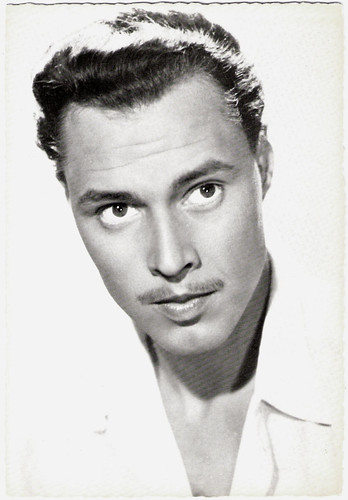
German postcard by WS-Druck, Wanne-Eickel, no. 393.

German postcard by Kunst und Bild, Wanne-Eickel, no. A 1321. Photo: Inter West-Gloria / Looschen. Publicity still for Herr über Leben und Tod/Master Over Life and Death (Victor Vicas, 1955).
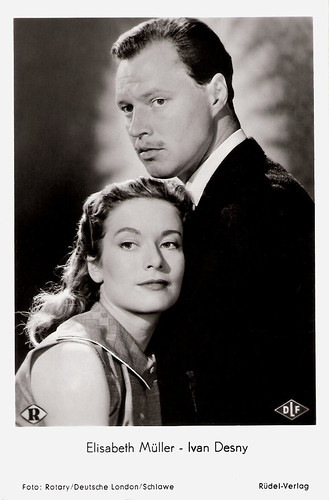
German postcard by Rüdel-Verlag, Hamburg-Bergedorf, no. 1364. Photo: Rotary / Deutsche London / Schlawe. Publicity still for André und Ursula/Andre and Ursula (Werner Jacobs, 1955) with Elisabeth Müller.
In the following years, Ivan Desny became popular as a cosmopolitan ladykiller with his goatee and a foreign accent. He starred opposite Maria Schell in Herr über Leben und Tod/Master Over Life and Death (Victor Vicas, 1955), opposite Elisabeth Müller in André und Ursula/ André and Ursula (Werner Jacobs, 1955), and opposite Sonja Ziemann in Mädchen ohne Grenzen/A Girl Without Boundaries (Géza von Radványi, 1955).
He also appeared in the masterpiece Lola Montès (Max Ophüls, 1955) with Martine Carol.
Then he played leading parts in two hits by Falk Harnack, Anastasia – die letzte Zarentochter/Anastasia: The Czar's Last Daughter (1956) and Wie ein Sturmwind/Tempestuous Love (1957). His partner in both films was Lilli Palmer. He also appeared in the Hollywood version of Anastasia (Anatole Litvak, 1956) starring Ingrid Bergman and Yul Brynner.
Other films in which he played were Une Vie/One Life (Alexandre Astruc, 1958) starring Maria Schell and Pascale Petit, Le miroir à deux faces/The Mirror Has Two Faces (André Cayatte, 1958) with Michèle Morgan and Bourvil, and the crime film Heiße Ware/Hot Stuff (Paul May, 1959) with Margit Saad.
He also appeared in Hollywood productions like the award-winning Song Without End (Charles Vidor, 1960) about the affairs of composer Franz Liszt played by Dirk Bogarde, and the Disney film Bon Voyage! (James Neilson, 1962) about the one-of-a-lifetime vacation in Paris of Fred MacMurray and Jane Wyman.
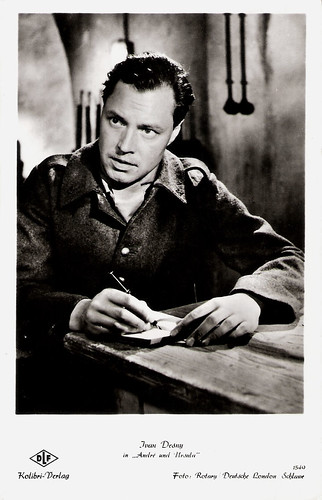
German postcard by Kolibri-Verlag, no. 1540. Photo: Rotary / Deutsche London / Schluwe. Publicity still for André und Ursula/Andre and Ursula (Werner Jacobs, 1955).
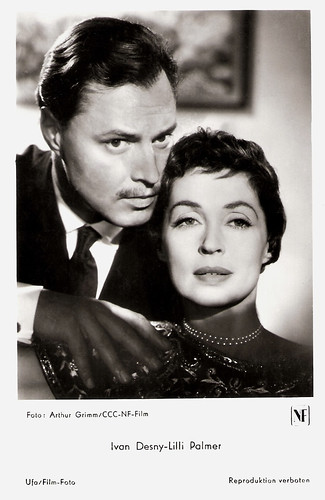
German postcard by Ufa, Wanne-Eickel, no. 393. Photo: Arthur Grimm / CCC / NF-Film. Publicity still for Anastasia - Die letzte Zarentochter/Anastasia: The Czar's Last Daughter (Falk Harnack, 1956) with Lilli Palmer.
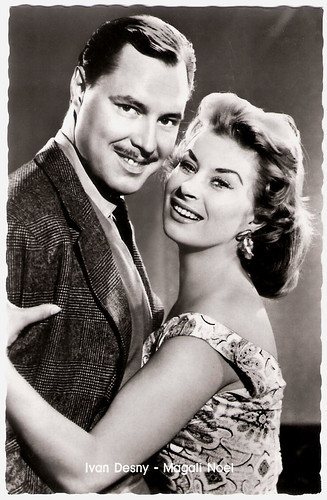
German postcard by Kolibri-Verlag G.m.b.H., Minden/Westf., no. 2531. Photo: Deutsche Cosmopol-Film. Publicity still for O.S.S. 117 n'est pas mort/O.S.S. 117 Is Not Dead (Jean Sacha, 1957) with Magali Noël.
During the decline of German cinema in the 1960s and 1970s, Ivan Desny focused on stage and television work. In the theatres, he often appeared with Nadja Tiller. Meanwhile, he showed up in small roles in such international pictures as La bataille de San Sebastian/The Battle of San Sebastian/Guns for San Sebastian (Henri Verneuil, 1968) with Anthony Quinn and Charles Bronson, Mayerling (Terence Young, 1968) with Omar Sharif and Catherine Deneuve, and Little Mother (Radley Metzger, 1973), based on the life story of Evita Peron. In the early years of the popular Krimi TV series Tatort (1971-1973), he regularly appeared as the mysterious Mr. Sievers, the brain after many criminal activities, who seemed untouchable.
Then he was discovered by the young directors of the Neue Deutsche Welle. Rainer Werner Fassbinder gave him a part in Welt am Draht/World on a Wire (1973) and in his masterpieces Die Ehe der Maria Braun/The Marriage of Maria Braun (1978) starring Hanna Schygulla, and Lola (1981) starring Barbara Sukowa. Desny also had a part in Fassbinder’s monumental TV series Berlin Alexanderplatz (1980). Klaus Lemke cast him in his TV film Sylvie (1973), and Wim Wenders engaged him for Falsche Bewegung/False Movement (1975).
Other films in which he appeared were the Sci-Fi film Who? (Jack Gold, 1973) with Elliott Gould, the thriller Touch Me Not (Douglas Fithian, 1974) with Lee Remick, Paper Tiger (Ken Annakin, 1975) with David Niven, Die Eroberung der Zitadelle/The Conquest of the Citadel (Bernhard Wicki, 1977), Bloodline (Terence Young, 1979) with Audrey Hepburn, and Malou (Jeanine Meerapfel, 1980) with Ingrid Caven. In 1980 the Frenchman Desny was awarded the German award Filmband in Gold for his longtime and outstanding contributions to German cinema.
Among his later films were Flügel und Fesseln/The Future of Emily (Helma Sanders-Brahms, 1985) with Brigitte Fossey and Hildegard Knef, the Anton Chekhov adaptation Hôtel de France (Patrice Chéreau, 1987), and the thriller Quicker Than the Eye (Nicolas Gessner, 1989) with Ben Gazzara. He also appeared in the biography God afton, Herr Wallenberg - En Passionshistoria från verkligheten/Good Evening, Mr. Wallenberg (Kjell Grede, 1990) starring Stellan Skarsgård as the mysterious WW II hero Raoul Wallenberg, La Désenchantée/The Disenchanted (Benoit Jacquot, 1990), and André Téchiné’s dramas J'embrasse pas/I Don't Kiss (1991) with Emmanuelle Béart, and Les Voleurs/Thieves (1996) with Catherine Deneuve.
In 2002 Desny got a lot of criticism for appearing in a magazine article as a healed cancer patient (which he wasn’t) and for advertising a controversial and in Germany forbidden anti-cancer compound, Galavit, as a miracle cure. That same year Ivan Desny died of pneumonia in Ascona, Switzerland. He had appeared in over 150 films.
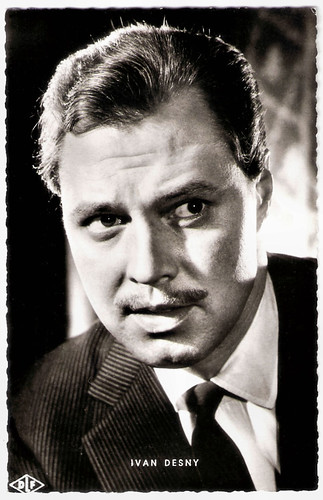
German postcard by Kunst und Bild, Berlin, no. S 588. Photo: Alfu / Corona / Deutsche London / Grimm. Publicity still for Anastasia - Die letzte Zarentochter/Anastasia (Falk Harnack, 1956). Ivan Desny, who appears here as the real-life Gleb Botkin (son of the Imperial family's doctor, who was shot along with them in 1918), also appears as the fictional Prince Paul Von Haraldsberg in the Ingrid Bergman film Anastasia (Anatole Litvak, 1956).
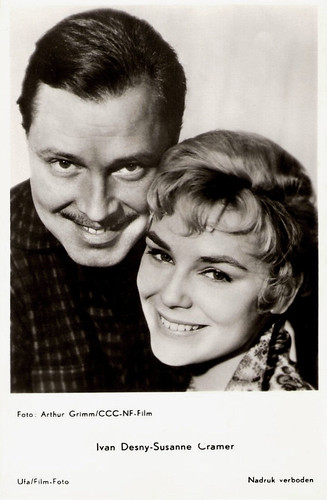
Dutch postcard by Gebr. Spanjersberg N.V., Rotterdam, no. 3305. Photo: Arthur Grimm / CCC / NF-Film. Spanjersberg was the Dutch licency holder for Ufa/Film-Foto (Universum-Film Aktiengesellschaft, Berlin-Tempelhof). Publicity still for Wie ein Sturmwind/Tempestuous Love (Falk Harnack, 1957) with Susanne Cramer.
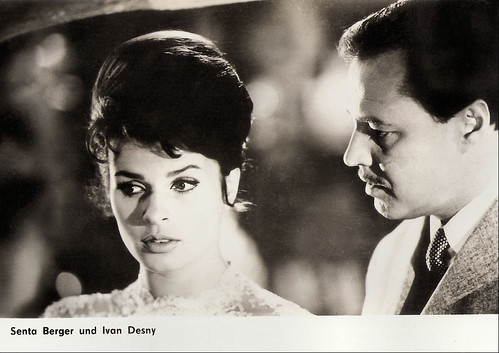
East-German postcard by VEB Progress Filmvertrieb, Berlin, no. 3012, 1967 Photo: publicity still for Sherlock Holmes und das Halsband des Todes/Sherlock Holmes and the Deadly Necklace (Terence Fisher, 1962) with Senta Berger.
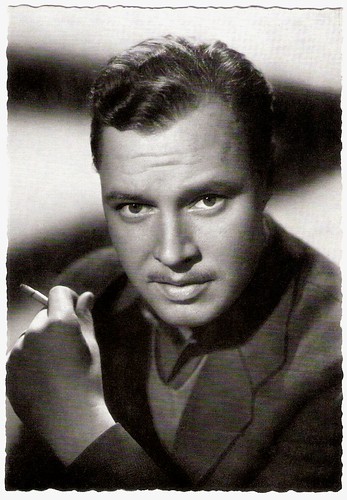
German postcard by WS-Druck, Wanne-Eickel, no. 13. Photo: Inter West-Gloria / List / Looschen.

German photo.
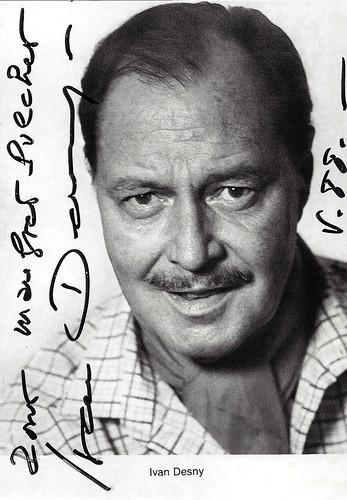
German postcard by Franz Josef Rüdel, Filmpostkartenverlag, Hamburg. Photo: Hilde Zemann, München (Munich).
Sources: Hal Erickson (AllMovie), Deutsches-Filmhaus.de (German), Wikipedia (German), and IMDb.
This post was last updated on 1 January 2024.

German postcard by UFA/Film-Foto (Universum-Film Aktiengesellschaft, Berlin-Tempelhof), no. CK-151. Photo: Arthur Grimm / UFA.

German postcard by Kolibri-Verlag G.m.b.H. Minden/Westf., no. 1719. Photo: Gamma / Union / Vogelmann. Publicity still for Lola Montez (Max Ophüls, 1955) with Martine Carol.

German postcard by Ufa, Berlin-Tempelhof, no. FK 3021. Photo: Michaelis / Carlton Film / NF. Publicity still for Rosen für Bettina/Ballerina (Georg Wilhelm Pabst, 1956).
Blackmailing social climber
Ivan Desny was born Ivan Nikolai Desnitzky in Peking (now Beijing), China, in 1922. He was the son of a Russian diplomat and a Swedish mother. As a child, he lived in Teheran, Washington, Paris and Brisbane.
It was his bad luck to be in Paris when the Nazis marched in. He spent the war in a German labour camp along with thousands of other Russian expatriates. After the war, he broke up his law studies and took acting classes in Paris. He made his stage debut at the famous boulevard theatre Théâtre de la Michodière under Pierre Fresnay.
He drifted into French films, first as an extra and as a costume and set designer, then as the leading man in the lost film La fleur de l'âge/The Flower of Youth (Marcel Carné, 1947) with Anouk Aimée and Arletty. The shooting of the film started several times and was halted for censorship reasons (the project was banned by the Ministry of Justice) and harsh shooting conditions, and finally, it was abandoned. All material was inexplicably lost in the 1950s.
Desny then appeared in Bonheur en location/Happiness on Location (Jean Wall, 1949), and soon started an international career. In London, he appeared as the blackmailing social climber Emile l'Angelier in Madeleine (David Lean, 1950) with Ann Todd. In France he starred in La putain respectueuse/The Respectful Prostitute (Charles Brabant, Marcello Pagliero, 1952), based on the play by Jean-Paul Sartre, and in Italy in La signora senza camelie/The Lady Without Camelias (Michelangelo Antonioni, 1953) with Lucia Bosé.
Then he went to Germany to appear as a Russian Army officer in Berlin after the war in Weg ohne Umkehr/No Way Back (Victor Vicas, Beate von Molo, 1953). The film won two German film awards and a Golden Globe as Best Foreign Film.

German postcard by WS-Druck, Wanne-Eickel, no. 393.

German postcard by Kunst und Bild, Wanne-Eickel, no. A 1321. Photo: Inter West-Gloria / Looschen. Publicity still for Herr über Leben und Tod/Master Over Life and Death (Victor Vicas, 1955).

German postcard by Rüdel-Verlag, Hamburg-Bergedorf, no. 1364. Photo: Rotary / Deutsche London / Schlawe. Publicity still for André und Ursula/Andre and Ursula (Werner Jacobs, 1955) with Elisabeth Müller.
Cosmopolitan ladykiller
In the following years, Ivan Desny became popular as a cosmopolitan ladykiller with his goatee and a foreign accent. He starred opposite Maria Schell in Herr über Leben und Tod/Master Over Life and Death (Victor Vicas, 1955), opposite Elisabeth Müller in André und Ursula/ André and Ursula (Werner Jacobs, 1955), and opposite Sonja Ziemann in Mädchen ohne Grenzen/A Girl Without Boundaries (Géza von Radványi, 1955).
He also appeared in the masterpiece Lola Montès (Max Ophüls, 1955) with Martine Carol.
Then he played leading parts in two hits by Falk Harnack, Anastasia – die letzte Zarentochter/Anastasia: The Czar's Last Daughter (1956) and Wie ein Sturmwind/Tempestuous Love (1957). His partner in both films was Lilli Palmer. He also appeared in the Hollywood version of Anastasia (Anatole Litvak, 1956) starring Ingrid Bergman and Yul Brynner.
Other films in which he played were Une Vie/One Life (Alexandre Astruc, 1958) starring Maria Schell and Pascale Petit, Le miroir à deux faces/The Mirror Has Two Faces (André Cayatte, 1958) with Michèle Morgan and Bourvil, and the crime film Heiße Ware/Hot Stuff (Paul May, 1959) with Margit Saad.
He also appeared in Hollywood productions like the award-winning Song Without End (Charles Vidor, 1960) about the affairs of composer Franz Liszt played by Dirk Bogarde, and the Disney film Bon Voyage! (James Neilson, 1962) about the one-of-a-lifetime vacation in Paris of Fred MacMurray and Jane Wyman.

German postcard by Kolibri-Verlag, no. 1540. Photo: Rotary / Deutsche London / Schluwe. Publicity still for André und Ursula/Andre and Ursula (Werner Jacobs, 1955).

German postcard by Ufa, Wanne-Eickel, no. 393. Photo: Arthur Grimm / CCC / NF-Film. Publicity still for Anastasia - Die letzte Zarentochter/Anastasia: The Czar's Last Daughter (Falk Harnack, 1956) with Lilli Palmer.

German postcard by Kolibri-Verlag G.m.b.H., Minden/Westf., no. 2531. Photo: Deutsche Cosmopol-Film. Publicity still for O.S.S. 117 n'est pas mort/O.S.S. 117 Is Not Dead (Jean Sacha, 1957) with Magali Noël.
Neue Deutsche Welle
During the decline of German cinema in the 1960s and 1970s, Ivan Desny focused on stage and television work. In the theatres, he often appeared with Nadja Tiller. Meanwhile, he showed up in small roles in such international pictures as La bataille de San Sebastian/The Battle of San Sebastian/Guns for San Sebastian (Henri Verneuil, 1968) with Anthony Quinn and Charles Bronson, Mayerling (Terence Young, 1968) with Omar Sharif and Catherine Deneuve, and Little Mother (Radley Metzger, 1973), based on the life story of Evita Peron. In the early years of the popular Krimi TV series Tatort (1971-1973), he regularly appeared as the mysterious Mr. Sievers, the brain after many criminal activities, who seemed untouchable.
Then he was discovered by the young directors of the Neue Deutsche Welle. Rainer Werner Fassbinder gave him a part in Welt am Draht/World on a Wire (1973) and in his masterpieces Die Ehe der Maria Braun/The Marriage of Maria Braun (1978) starring Hanna Schygulla, and Lola (1981) starring Barbara Sukowa. Desny also had a part in Fassbinder’s monumental TV series Berlin Alexanderplatz (1980). Klaus Lemke cast him in his TV film Sylvie (1973), and Wim Wenders engaged him for Falsche Bewegung/False Movement (1975).
Other films in which he appeared were the Sci-Fi film Who? (Jack Gold, 1973) with Elliott Gould, the thriller Touch Me Not (Douglas Fithian, 1974) with Lee Remick, Paper Tiger (Ken Annakin, 1975) with David Niven, Die Eroberung der Zitadelle/The Conquest of the Citadel (Bernhard Wicki, 1977), Bloodline (Terence Young, 1979) with Audrey Hepburn, and Malou (Jeanine Meerapfel, 1980) with Ingrid Caven. In 1980 the Frenchman Desny was awarded the German award Filmband in Gold for his longtime and outstanding contributions to German cinema.
Among his later films were Flügel und Fesseln/The Future of Emily (Helma Sanders-Brahms, 1985) with Brigitte Fossey and Hildegard Knef, the Anton Chekhov adaptation Hôtel de France (Patrice Chéreau, 1987), and the thriller Quicker Than the Eye (Nicolas Gessner, 1989) with Ben Gazzara. He also appeared in the biography God afton, Herr Wallenberg - En Passionshistoria från verkligheten/Good Evening, Mr. Wallenberg (Kjell Grede, 1990) starring Stellan Skarsgård as the mysterious WW II hero Raoul Wallenberg, La Désenchantée/The Disenchanted (Benoit Jacquot, 1990), and André Téchiné’s dramas J'embrasse pas/I Don't Kiss (1991) with Emmanuelle Béart, and Les Voleurs/Thieves (1996) with Catherine Deneuve.
In 2002 Desny got a lot of criticism for appearing in a magazine article as a healed cancer patient (which he wasn’t) and for advertising a controversial and in Germany forbidden anti-cancer compound, Galavit, as a miracle cure. That same year Ivan Desny died of pneumonia in Ascona, Switzerland. He had appeared in over 150 films.

German postcard by Kunst und Bild, Berlin, no. S 588. Photo: Alfu / Corona / Deutsche London / Grimm. Publicity still for Anastasia - Die letzte Zarentochter/Anastasia (Falk Harnack, 1956). Ivan Desny, who appears here as the real-life Gleb Botkin (son of the Imperial family's doctor, who was shot along with them in 1918), also appears as the fictional Prince Paul Von Haraldsberg in the Ingrid Bergman film Anastasia (Anatole Litvak, 1956).

Dutch postcard by Gebr. Spanjersberg N.V., Rotterdam, no. 3305. Photo: Arthur Grimm / CCC / NF-Film. Spanjersberg was the Dutch licency holder for Ufa/Film-Foto (Universum-Film Aktiengesellschaft, Berlin-Tempelhof). Publicity still for Wie ein Sturmwind/Tempestuous Love (Falk Harnack, 1957) with Susanne Cramer.

East-German postcard by VEB Progress Filmvertrieb, Berlin, no. 3012, 1967 Photo: publicity still for Sherlock Holmes und das Halsband des Todes/Sherlock Holmes and the Deadly Necklace (Terence Fisher, 1962) with Senta Berger.

German postcard by WS-Druck, Wanne-Eickel, no. 13. Photo: Inter West-Gloria / List / Looschen.

German photo.

German postcard by Franz Josef Rüdel, Filmpostkartenverlag, Hamburg. Photo: Hilde Zemann, München (Munich).
Sources: Hal Erickson (AllMovie), Deutsches-Filmhaus.de (German), Wikipedia (German), and IMDb.
This post was last updated on 1 January 2024.
No comments:
Post a Comment